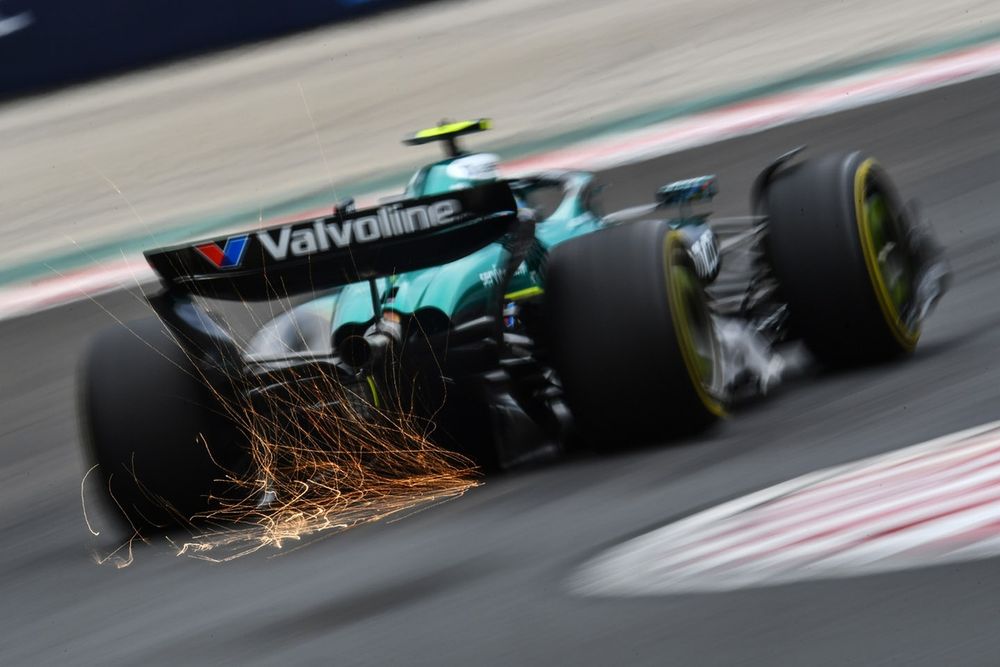Performance gains have become harder to find as F1’s second ground-effect aerodynamics era matures, but for some, the process has been more challenging for others. Aston Martin has noticeably struggled to unlock more relative pace from its cars ever since making a strong start to the 2023 season.
This has not been for want of trying since the Silverstone-based team has been among the most industrious in bringing new components to the track. The problem has been that many of them have had to come straight off again, having failed to behave as predicted in simulation.
New managing technical partner Adrian Newey has been frank in his assessment of the team’s R&D tools – particularly the driver-in-loop simulator.
“You learn from mistakes and you learn from the things that didn’t work,” Alonso said when asked by Motorsport how useful the experience of sub-optimal upgrades can be in terms of assessing new ideas.
“But I don’t think that it was a great thing to bring upgrades that didn’t deliver what we were expecting. So there were some kind of mistakes in the process of designing something, producing something and believing that it will make the car faster.
“And when those parts are not making the car faster, you need to undo some of the steps and know where the mistake was made. And as I said, even if we learn from that, it should never have happened.

Fernando Alonso, Aston Martin Racing
Photo by: James Sutton / Formula 1 / Formula Motorsport Ltd via Getty Images
“Because this is Formula 1, not an academy to test things. Here you have to deliver.”
This has become a familiar theme since the middle of the 2023 season, where the team faded after a strong start. Last year after the British Grand Prix, Lance Stroll said, “Every upgrade we’ve brought, we haven’t seen the benefit that we were hoping to see over the last year.”
Among the more painful experiences was the introduction of a new front wing, bodywork and underfloor profiling for the US GP weekend, following a previous large update package in Hungary. This was deemed a failure and most of it was rolled back in Mexico; the situation triggered yet another restructure in which technical director Dan Fallows was removed from his post and new CEO Andy Cowell added the team principal role to his business card.
This season has presented a different but related set of problems in that the AMR25 was not especially competitive ‘out of the box’ – and while updates have offered some improvement, that has been incremental.
Aston applied its first major upgrade package of the year during the Emilia Romagna Grand Prix weekend: another new floor and diffuser geometry, along with top bodywork revisions and a new rear beam wing profile. A clear sign of lack of confidence in the simulation tools and correlation came when it evaluated its cars back to back, with Lance Stroll running the new spec during Friday practice and Fernando Alonso retained the previous one.
But while the new package appeared to yield an improvement during qualifying as both drivers progressed to Q3, neither finished in the points. High drag and inconsistent handling has continued to bedevil the car despite another big update at Silverstone, which Alonso described as “a small step” performance-wise.
The team has introduced new, circuit-specific front and rear wings since then, and has not ruled out adding further elements before the end of the season.
As Cowell, speaking exclusively to Motorsport, said in Hungary, the process has been a result of proving out the new on-site wind tunnel in Aston Martin’s Silverstone ‘technology campus’, doing research first in the Mercedes tunnel and then in the new facility. The Imola update was intended to be the last of the season but proved encouraging enough for Cowell to sanction more, albeit limited, development.

Andy Cowell, Team Principal and Group CEO Aston Martin F1 Team
Photo by: Zak Mauger / LAT Images via Getty Images
“We know last year we won the championship of the number of upgrades,” he said.
“Which means the effort that was put in by everybody, from aerodynamicists and car designers, composite designers, supply chain, internal manufacturing, and the teams preparing all the hardware to go to the track, and the mechanics at the track to fit new bits, a tremendous amount of activity.
“And if you don’t get the reward of the lap time improving, it’s not a great position to be in. It’s not good for confidence of an organisation or morale.
“So, holding off until Imola was important to make sure that everything was in place. We were ready to go, we said we’ll do upgrades when they’re ready. And so the joy in the debrief that we did back here after Imola was great to experience.
“And now we just need to build on that. We need to build on our understanding of the world of flow physics and the world of aerodynamics, all the way into our analysis tools so that we’ve got even more confidence with the work that we do going forwards for ’26 and beyond.”
While this paints a reassuring picture of the future, Alonso and Stroll have the rest of 2025 to get through. And there, race by race, they will be looking at a car which qualified at the back of the grid in Belgium, then was only a tenth off pole in Hungary a week later – and wondering which side of its personality they’re going to get.
In this article
Be the first to know and subscribe for real-time news email updates on these topics

